
Édouard Manet (1832 – 1883)
On January 23, 1832, French modernist painter Édouard Manet was born. Manet was one of the first 19th-century artists to paint modern life, as well as a pivotal figure in the transition from Realism to Impressionism.
“I was painting modern Paris while you were still painting Greek athletes.”
– Edouard Manet, c. 1879
Edouard Manet – Family Background and Childhood
Édouard Manet was born in the Saint-Germain-des-Prés district of Paris, directly opposite to the Académie des Beaux-Arts not far from the Louvre. He came from a bourgeois family with republican sentiments. His father, Auguste Manet, was a judge and worked as head of the personnel department at the Ministry of Justice. His mother, Eugénie-Désirée Manet, née Fournier, was the daughter of a French diplomat who worked as consul in Gothenburg. From 1838 to 1844, Manet attended the institute school in Vaugirard run by Abbé Poiloup. He then transferred to the prestigious Collège Rollin (today’s Lycée Jacques Decour), where he completed his schooling in 1848. There he met the future journalist and politician Antonin Proust, with whom he had a lifelong friendship. Manet was popular with his classmates because he drew caricatures of them and the teachers. His uncle Fournier recognized the student’s talent for drawing and paid for him to take optional drawing lessons at the Collège Rollin. Manet made his first drawings after Old Masters at the Louvre during these years and also drew in the open air during excursions to Vincennes.
Brazil and the Studio of Thomas Couture
Manet aspired to a career as a naval officer but failed the entrance examination to the naval school. He went on a six-month voyage to Brazil, during which he reported on his experiences, took a critical look at slavery, and decided to become a painter instead of retaking the naval school exam. Manet’s father preferred him to study at the Académie des Beaux-Arts, but Manet himself preferred a studio class with an artist. They ultimately agreed on the studio of Thomas Couture, where Manet began his training in 1850. Manet initially admired Couture’s skills, but after six months, he began to criticize the unnatural attitude of the models and Couture’s teaching methods, which led to conflict. Despite the difficult relationship, Manet remained in the studio class for six years before he separated from Couture in 1856 and moved into his own studio with a friend.
The first own Studio
Little is known about Manet’s work up to 1859 because there are hardly any records on the creation of the early works, Manet’s working method of revising works over a period of years and Manet destroyed some of his early paintings. The surviving paintings of the early years do not yet reveal the artist’s own style. Thus, he copied paintings by Old Masters. Manet made friends with painters Edgar Degas [1] and Henri Fantin-Latour, and the poet Charles Baudelaire [2] during this period, who inspired Manet to paint his first independent painting, The Absinthe Drinker. After a tragic incident in his studio, Manet moved into his own studio in the Rue de la Victoire.
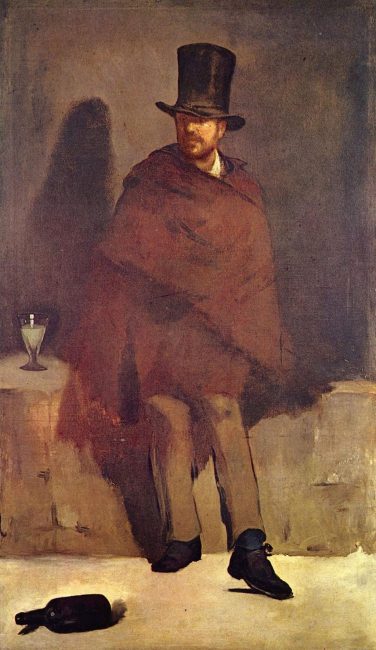
The Absinthe Drinker c. 1859, Ny Carlsberg Glyptotek, Copenhagen
Premiere in the Salon
In 1859, Manet submitted his painting “The Absinthe Drinker” to the prestigious Salon de Paris, only to have it rejected by the jury. Believing the rejection to be a calculated move by his former instructor, Thomas Couture, Manet persisted in his artistic endeavors. The following year, at the 1861 Salon, he submitted two works, a portrait of his parents and “Guitarrero.” While the portrait received mixed reviews, “Guitarrero” was met with widespread acclaim, earning Manet an honorable mention from the Salon jury. The success of “Guitarrero” led to a group of young painters, including Henri Fantin-Latour, Felix Bracquemond, Emile Auguste Carolus-Duran, and Alphonse Legros, gathering around Manet, viewing him as a leader. This group also included writers such as Charles Baudelaire, Jules Champfleury, and Édmond Duranty.
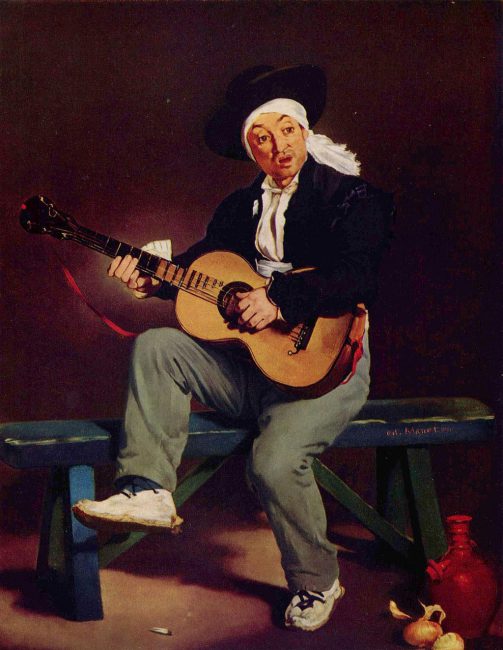
Chanteur Espagnol, 1860
Suzanne Leenhoff and her Son
In 1860, Manet made the significant step of moving out of his parents’ home and into his own apartment in the Batignolles district. He was accompanied by the Dutch pianist Suzanne Leenhoff, who was two years his senior, and her son Léon. The identity of Léon’s father is uncertain, as he was presented as Suzanne’s younger brother during their time in Paris. Despite temporarily keeping his relationship with Suzanne a secret from his friends, Manet ultimately married her in 1863, following the death of his father.
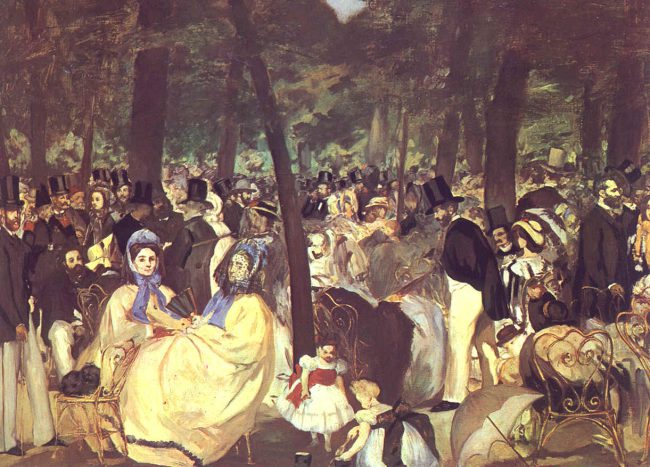
Musique aux Tuileries, 1862
Manet, the Flaneur
As a committed city-dweller, Manet’s life was closely tied to Paris, and he rarely ventured beyond its borders. He spent his days strolling through the streets, elegantly dressed and socializing with progressive painters, writers, and politicians at the various restaurants, cafés, and vaudevilles he frequented. He even depicted himself as a member of this bustling, bourgeoisie society in his painting “Music in the Tuileries Garden.” Depictions of modern life, or la vie moderne, became a recurring theme in Manet’s later works. In 1862, he also founded the Societé des Aquafortistes, an association of artists dedicated to promoting the art of etching. During this time, Manet himself produced many etchings, many of which were published.
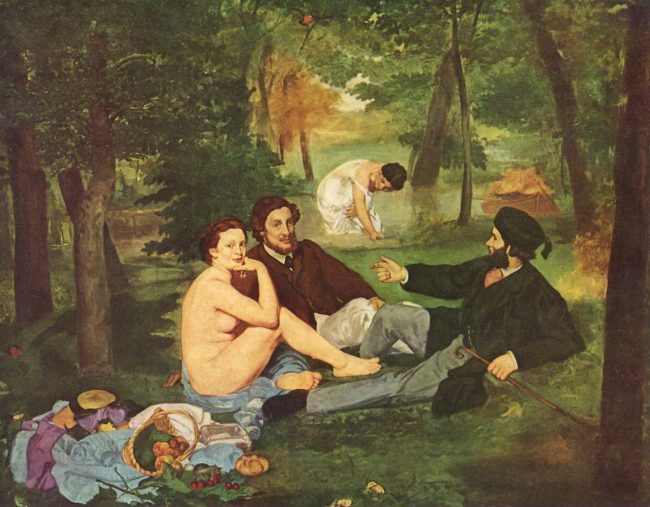
Déjeuner sur l’Herbe, 1863
The Spanish Fashion of the 19th Century
Before the 19th century, Spanish painting received little attention in France, where artists primarily looked to Italian art for inspiration. However, the Napoleonic Wars brought Spanish art to the Louvre as looted art and sparked interest in the country’s culture. In the 1850s, a Spanish fashion emerged in France after Napoleon III married a Spanish woman, and a troupe of Spanish dancers received enthusiastic receptions in the early 1860s. Manet was inspired by the success of his painting “The Spanish Singer” and began to incorporate Spanish motifs in his work. Spanish artists such as Diego Velázquez and Francisco de Goya [3] were a constant source of inspiration for Manet until the end of his career.
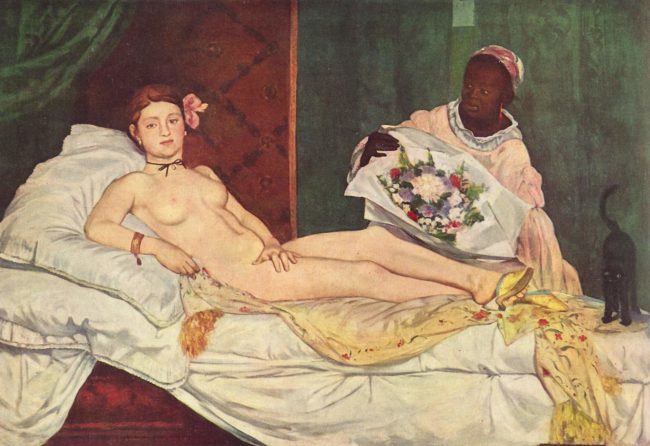
Olympia, 1863
Later Years
Manet’s painting, The Luncheon on the Grass ,[6] was rejected by the Salon de Paris due to its crude style and depiction of nudity. It was later exhibited in 1863 at the Salon des Refusés.[4] His painting Olympia also caused a scandal at the Salon in 1865. Manet was on friendly terms with the young Impressionist artists but did not consider himself a part of the movement. He had a great influence on young artists despite the official rejection of his work. In 1882, he was awarded a second-class medal and made a Knight of the Legion of Honor for his portrait M. Henri Rochefort. Manet had a lifelong friendship with Édmond Duranty and briefly met Berthe Morisot, a famous female Impressionist painter, before his death in 1883 due to complications from syphilis.
Emily A. Beeny: “Édouard Manet and the Illusion of Effortlessness”, [5]
References and Further Reading:
- [1] The Dancers of Edgar Degas, SciHi Blog
- [2] Charles Baudelaire and the Flowers of Evil, SciHi Blog
- [3] Francisco de Goya, Herald of Modernity, SciHi Blog
- [4] The Paris Salon des Refusés of 1863, SciHi Blog
- [5] Emily A. Beeny: “Édouard Manet and the Illusion of Effortlessness”, The Frick Collection @ youtube
- [6] Paul Hayes Tucker, Manet’s Le Déjeuner sur l’herbe, Cambridge University Press, 1998
- [7] Tedman, Gary (2012). Paris 1844, Manet and Courbet: from Aesthetics and Alienation. Zero Books.
- [8] Krell, Alan (1996). Manet and the Painters of Contemporary Life. Thames and Hudson.
- [9] Mauner, G. L.; Loyrette, H. (2000). Manet: The Still-Life Paintings. New York: H.N. Abrams
- [10] Works by or about Édouard Manet at Internet Archive
- [11] Timeline for Edouard Manet, via Wikidata





